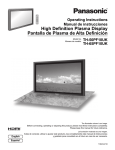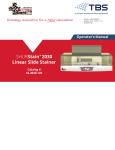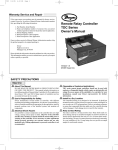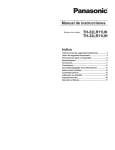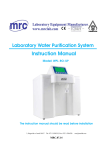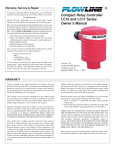Download TDS Manual V2.0.qxd - Dwyer Instruments, Inc.
Transcript
Warranty, Service & Repair If for some reason your product must be returned for factory service, contact Dwyer Inc. at (219)879-8000 to receive a Material Return Authorization number (MRA), providing the following information: 1. Part Number, Serial Number 2. Name and telephone number of someone who can answer technical questions related to the product and its application. 3. Return Shipping Address 4. Brief Description of the Symptom 5. Brief Description of the Application Once you have received a Material Return Authorization number, ship the product prepaid in its original packing to: Thermal Dispersion Flow Switch TDS Series Owner’s Manual Dwyer Instruments Inc. PO Box 373 102 Indiana Hwy, 212 Michigan City, IN 46361 Please include the information about the malfunction with your product. This information enables our service technicians to process your repair order as quickly as possible. IP 68 Version 2.0.1A All rights reserved WARRANTY Step One About this Manual: Material Compatibility: PLEASE READ THE ENTIRE MANUAL PRIOR TO INSTALLING OR USING THIS PRODUCT. This manual includes information on all models of Dwyer Thermal Dispersion Flow Switches: TDS series. Please refer to the part number located on the switch label to verify the exact model which you have purchased. The TDS series sensors are available in two different wetted materials. Models TDS 1__ are made of Polypropylene (PP) with Ryton tips. Models TDS 2__ are made of Polyvinylidene Fluoride (PVDF). Make sure that the model you have selected is compatible with the application liquid. To determine the chemical compatibility between the sensor and its application liquids, refer to an industry reference such as the Compass Corrosion Guide (available from Compass Publications, phone 858-589-9636). User’s Responsibility for Safety: Dwyer manufactures a wide range of flow switches and technologies. While each of these sensors is designed to operate in a wide variety of applications, it is the user’s responsibility to select a sensor model that is appropriate for the application, install it properly, perform tests of the installed system, and maintain all components. The failure to do so could result in property damage or serious injury. Proper Installation and Handling: Because this is an electrically operated device, only properlytrained staff should install and/or repair this product. Use a proper sealant with all installations. Never overtighten the sensor within the fitting, beyond a maximum of 80 inch-pounds torque. Always check for leaks prior to system start-up. Wiring and Electrical: The supply voltage used to power the sensor should never exceed a maximum of 36 volts DC. Electrical wiring of the sensor should be performed in accordance with all applicable national, state, and local codes. Flammable, Explosive and Hazardous Applications: DO NOT USE THE TDS SERIES GENERAL PURPOSE FLOW SWITCHES IN HAZARDOUS LOCATIONS. WARNING The rating for the relay is 120 VAC/60 VDC @ 1A. For CE rated applications, the relay rating is 60 VAC/60 VDC @ 1A. Dwyer’s Thermal Dispersion flow switches are not recommended for use with electrically charged application liquids. For most reliable operation, the liquid being measured may need to be electrically grounded. SPECIFICATIONS Step Two Thermal Dispersion Ultrasonic Level Switch, LU10 Series Electronics temp.: Pressure: Sensor rating: Sensor material: Cable jacket mat.: Cable type: Cable length: Process mount: Classification: CE compliance: 0.7" 8’ Cable (2.5m) 2.1" (54mm) 2.8" (71mm) 4.5" (114mm) 3/4" NPT 3/4" NPT 0.7" Contact output: Process temp.: 3/4" NPT (19mm) Factory set point: Repeatability: Response time: Set point adjust.: Viscosity range: Supply voltage: Consumption: Contact type: Contact rating: 3/4" NPT .04 to 3 fps (.012 to .91 mps) .2 fps (.06 mps) ± .5% of set point 1-10 seconds Potentiometer 1-200 centipoise 12-36 VDC 70 mA maximum (1) SPST relay 120 VAC/VDC @ 1A (CE: 60 VAC/VDC @ 1A) Selectable NO/NC F: 32˚ to 140˚ C: 0˚ to 60˚ F: -40˚ to 140˚ C: -40˚ to 60˚ 150 psi (10 bar) @ 25˚ C., derated @ 1.667 psi (.113 bar) per ˚C. above 25˚ C. NEMA 4X (IP65) TDS1: PP-Ryton® TDS2: PVDF Kynar® TDS1: PP TDS2: PFA Teflon® 4-conductor, #22 AWG (shielded) 10' (3m) 3/4" NPT General purpose EN 50082-2 immunity EN 55011 emission EN 61010-1 safety 8’ Cable (2.5m) 0.7" (19mm) 1.3" (32mm) 3.0" (76mm) * all dimensions are Nominal Set Points: The TDS liquid flow switch set point is factory calibrated to 0.2 fps. To convert feet/sec to GPM, please refer to the chart below. TDS Series Volume vs Velocity 12" 10" 8" 1000 Flow Rate (gpm) Set point range: (19mm) Common Specifications: 6" 4" 3" 2" 1-1/2" 1" 3/4" 1/2" 100 10 1 0.1 0.01 .01 .04 .1 TDS Series Flow Switch .2 Velocity (fps) 1 3 10 TDS _ _ 2 Sensor Material 1 - PP 2 - PVDF Sensor Length 1 - Short 2 - Long Maximum Temperature/Voltage Derating @ Maximum Current 150 Unacceptable Range 125 100 075 050 Acceptable Range 025 000 00 20 40 60 Temperature (C¡) PVDF 80 PP 100 Electrical Loading Limits 100 80 Unacceptable Range 60 40 20 00 12 Acceptable Range 18 24 30 Operating Voltage (VDC) 36 Max. Series Resistance (Ohms) 175 Ambient Sensor Temperature (C¡) Operating Pressure (psi) Temperature/Pressure Derating 1,400 1,200 1,000 800 600 400 Unacceptable Range Acceptable Range 200 0 12 18 24 30 Supply Voltage (VDC) 36 INTRODUCTION INSTALLATION Step Three Step Four Technology: The TDS series flow switch when installed must always be in contact with the liquid being measured. The flow switch feature a 3/4" NPT threads which will allow it to be used with various types of fittings. Be sure to check the insertion depth of the flow switch in the fitting after it is installed. See the diagram below for the recommended insertion depth. The thermal dispersion flow switch measures liquid temperature to determine changes in flow velocity. As fluid flows across the sensing tips, the temperature is reduced proportionately as a function of the flow rate. When a temperature or velocity shift reaches the user defined set point, the switch changes state indicating the appropriate flow condition (flow or no-flow). Dwyer's sophisticated electronics convert the temperature shift into a signal which indicates whether a flow or no-flow condition occurs. Depending on how the sensor is wired, this signal may be wired for normally open or normally closed circuits. Dwyer's Thermal Dispersion flow switches have no moving parts to clog or foul, making them suitable for a variety of applications, including non-coating and non-scaling liquids. The TDS series directly measure mass flow and can operate over a broad range of liquids from 0.4 to 1.2 specific gravity, 1 to 200 cp. Initialization Sequence for TDS series: Powering up the TDS series is different in water and in air. When the flow switch is powered up while submersed, the TDS series will immediately indicate flow before switching to its correct state. When the flow switch is powered up while in air, the TDS series will immediately indicate no-flow before indicating its correct state. A time delay may be used to eliminate this initialization sequence. Dwyer's thermal dispersion relay controllers feature a 0 to 60 second time delay for your convenience. le e tab ng ep n Ra c Ac rtio e Ins in. Dm 1/8 I ipe P D eI Pip When using any type of fitting, the orientation as well as the insertion depth of the flow switch in the pipe is critical. See the diagram below for the recommended orientation depth. WARNING The flow switch tips have a thin plastic wall which may be damaged if dropped or installed improperly. The TDS series flow switch is designed for use in liquid. For best results, avoid installing the TDS series where bubbles are present or where the tips of the switch may be out of the liquid. WIRING WIRING Step Five Step Six Supply Voltage: The supply voltage to the TDS series flow switch should never exceed a maximum of 36 VDC. Use controllers or power supplies, with a minimum output of 12 VDC or a maximum output of 36 VDC. Wiring the Relay Output: Required Cable Length: Determine the length of cable required between the TDS series flow switch and its point of termination. Allow enough slack to ensure the easy installation, removal and/or maintenance of the sensor. The cable length may be extended up to a maximum of 1000 feet, using a well-insulated, 14 to 20 gauge shielded four conductor cable. Wire Stripping: Using a 10 gauge wire stripper, carefully remove the outer layer of insulation from the last 1-1/4" of the sensor's cable. Unwrap and discard the exposed foil shield from around the signal wires, leaving the drain wire attached if desired. With a 20 gauge wire stripper, remove the last 1/4" of the colored insulation from the signal wires. Signal Output (Relay switching): Allows the sensor to switch a small load on or off directly, using an internal 1A relay [120 VAC/VDC or (CE: 60 VAC/VDC)]. The NO/NC status is set by the polarity of the voltage feeding the red and black wires. The green wire is the common for the relay and the white wire is the NO or NC, depending on the polarity of red and black. Normally Open Wiring: Red + 24 VDC Power Supply - Black Shield Ground White - Green + Multimeter (Continuity) Wiring to a Dwyer Controller: AC (S) (-) GND NC R C 115 VAC 220 VAC NO DELAY (+) Red Black Green White Shield - Not Used AC P INVERT +/- IN PU T 1 TSP Series Controller The TDS series relay output can be wired as a dry contact to a VDC or VAC power source. The TDS series does require 12 - 36 VDC power to operate the sensor and switch the relay. All illustrations below identify a Dry switch state as the normal position of the relay. Switching a Normally Open DC Load: The Red wire connects to Positive (+) of the power supply and the Black wire connects to Negative (-). The LOAD can be attached to either the Green or White wires. Complete the circuit by either connecting the Green to (+) VDC power or White to (-) VDC power (see illustration below). [Flow Condition] Sensor (NO) INVERT DELAY INVERT -- + DELAY -- + RELAY 1 RELAY 2 INPUT2A White Black Green Red Not Used - Shield ONOFF OR LOAD [-] [Flow Condition] Sensor (NC) BLK GRN SHLD WHT RED [+] LOAD OR LOAD [-] Switching a Normally Open AC Load: The Red wire connects to Positive (+) of the DC power supply and the Black wire connects to Negative (-). The LOAD can be attached to the Green wire and the Hot of the VAC power. Connect the White to the Neutral of the VAC power (see illustration below). [Flow Condition] Sensor (NO) RED GRN SHLD WHT BLK [+] LOAD [AC Power] [-] Switching a Normally Closed AC Load: The Black wire connects to Positive (+) of the DC power supply and the Red wire connects to Negative (-). The LOAD can be attached to the Green wire and the Hot of the VAC power. Connect the White to the Neutral of the VAC power (see illustration below). [Flow Condition] LATCH INPUT1 [+] LOAD Switching a Normally Closed DC Load: The Black wire connects to Positive (+) of the power supply and the Red wire connects to Negative (-). The LOAD can be attached to either the Green or White wires. Complete the circuit by either connecting the Green to (+) VDC power or White to (-) VDC power (see illustration below). TDC Series Controller POWER RED GRN SHLD WHT BLK INPUT2B Sensor (NC) BLK GRN SHLD WHT RED [+] LOAD [AC Power] [-] WIRING CALIBRATION Step Seven Step Eight Wiring as a P-Channel or N-Channel output: Set Points: The TDS series relay output can be substituted for either a P-Channel (PNP, sourcing) output or a N-Channel (NPN, sinking) output. If the preset factory calibration is not adequate for your application, follow the calibration steps listed below. Note: the switch's internal LED will be on when the switch detects no-flow and will off when the switch detects flow. Normally Open DC Load as a P-Channel Output: To wire as a NO P-Channel output, follow the directions below. The Red wire connects to Positive (+) of the power supply and the Black wire connects to Negative (-). The Green wire is jumpered to the Red wire while the White wire is connected to the LOAD. Jumper the LOAD back to the Negative (-) to complete the circuit. [Flow Condition] Sensor (NO) RED GRN SHLD WHT BLK [+] LOAD [-] Normally Closed DC Load as a P-Channel Output: To wire as a NC P-Channel output, follow the directions below. The Black wire connects to Positive (+) of the power supply and the Red wire connects to Negative (-). The Green wire is jumpered to the Black wire while the White wire is connected to the LOAD. Jumper the LOAD back to the Negative (-) to complete the circuit. [Flow Condition] Sensor (NC) BLK GRN SHLD WHT RED [+] LOAD [-] Normally Open DC Load as a N-Channel Output: To wire as a NO N-Channel output, follow the directions below. The Red wire connects to Positive (+) of the power supply and the Black wire connects to Negative (-). The White wire is jumpered to the Black wire while the Green wire is connected to the LOAD. Jumper the LOAD back to the Positive (+) to complete the circuit. [Flow Condition] Sensor (NO) 2. Locate the potentiometer knob at the top of the flow switch. The red LED is visible through the potentiometer. (If the LED is on, slowly adjust the potentiometer counterclockwise, with a small flat head screwdriver until the LED turns off.) The adjustment is a single turn 270° potentiometer. The initial response time of the flow switch after adjustment is 1 to 10 seconds. Adjust the potentiometer in slow increments and wait for the response. [+] LOAD [-] [Flow Condition] BLK GRN SHLD WHT RED [+] LOAD [-] Potentiometer Knob If the LED is off, slowly adjust the potentiometer clockwise until the light turns on. Then turn the potentiometer counterclockwise to bring the LED off at a reliable setting. Remember, adjust the potentiometer in slow increments and wait for the response. 3. Verify that the new calibration is correct by lowering the system flow rate below the set point and check to see that the red LED turns on. Then increase the flow rate above the set point and verify that the red LED turns off accordingly. TDS Series 0.2 fps .04 fps RED GRN SHLD WHT BLK Normally Closed DC Load as a N-Channel Output: To wire as a NC N-Channel output, follow the directions below. The Black wire connects to Positive (+) of the power supply and the Red wire connects to Negative (-). The White wire is jumpered to the Red wire while the White wire is connected to the LOAD. Jumper the LOAD back to the Positive (+) to complete the circuit. Sensor (NC) 1. Install the fitting and flow switch as described in the Installation section of this manual. Turn the flow switch and controller power on and adjust the flow rate to the application setting. If the medium to be sensed is likely to be subject to high temperature variations, the flow switch should be set at the highest normal temperature likely to be encountered. 3 fps MAINTENANCE Step Nine Step Ten General: The TDS series flow switch requires no periodic maintenance except to clean off any deposits or scaling from the sensor tip as necessary. It is the responsibility of the user to determine the appropriate maintenance schedule, based on the specific characteristics of the application liquids. Cleaning Procedure: 1. Power: Make Sure that all power to the sensor, controller and/or power supply is completely disconnected. 2. Sensor Removal: Make sure that the flow is off and the pressure is down prior to removing the TDS series flow switch. Carefully, remove the sensor from the installation. Replace the sensor with a 3/4” NPT plug to insure that liquid does not leak out during this procedure. Do not re-install the flow switch if the threads are damaged. 3. Cleaning the Sensor: Use a soft bristle brush and mild detergent, carefully wash the TDS series flow switch. Do not use harsh abrasives such as steel wool or sandpaper, which might damage the surface sensor. Do not use incompatible solvents which may damage the sensor's PP/Ryton or PVDF plastic body. 4. Sensor Installation: Follow the appropriate steps of installation as outlined in the installation section of this manual. Testing the installation: 1. Power: Turn on power to the controller and/or power supply. 2. Immersing the switch: Immerse the sensing tip in its application liquid, by filling the tank up to the switches point of actuation. An alternate method of immersing the switch during preliminary testing is to hold a cup filled with application liquid up to the switch's tip. 3. Test: With the switch being fluctuated between wet and dry states, the switch indicator light in the controller should turn on and off. If the controller doesn't have an input indicator, use a voltmeter or ammeter to ensure that the switch produces the correct signal. 4. Point of actuation: Observe the point at which the rising or falling fluid level causes the switch to change state, and adjust the installation of the switch if necessary. This Space Left Intentionally Blank






